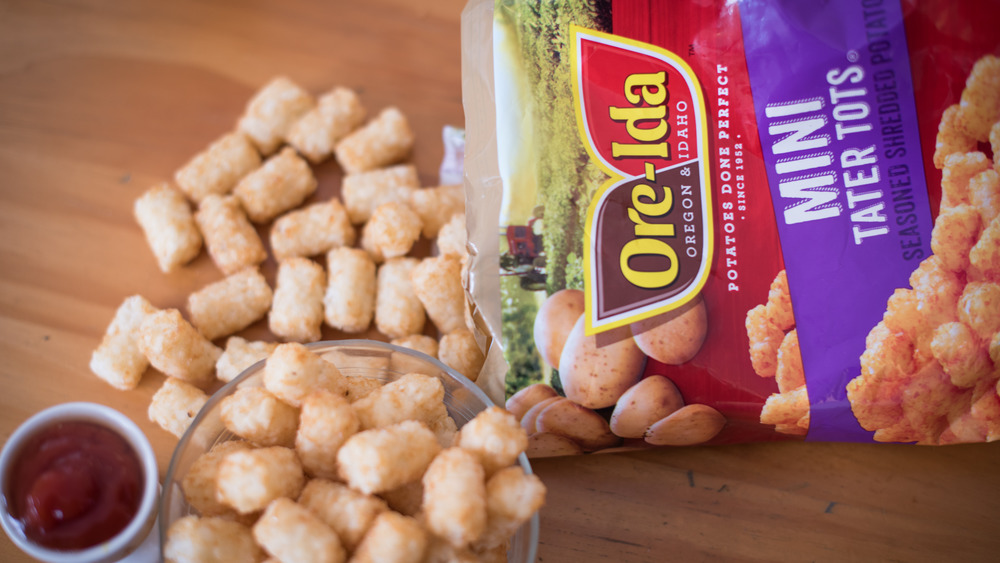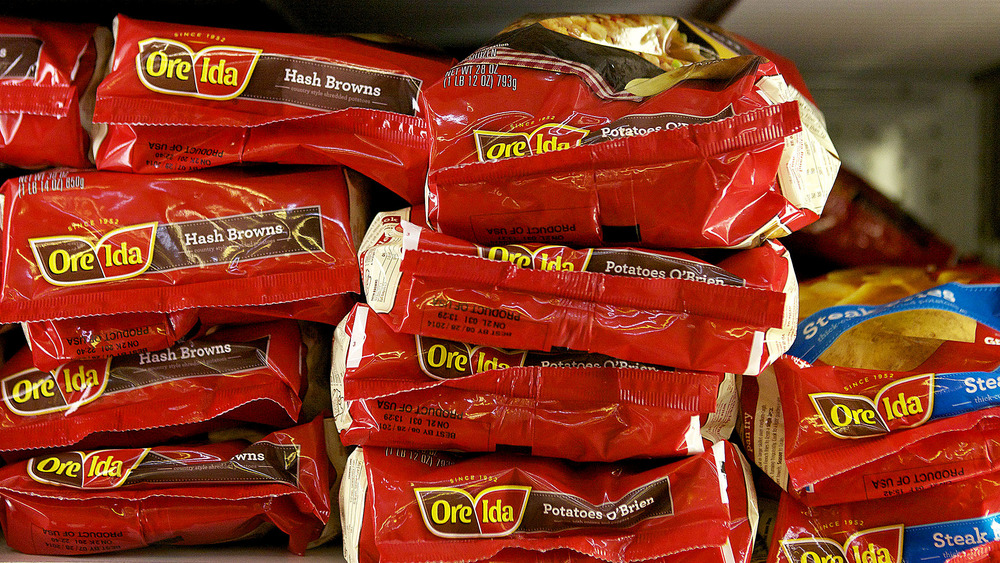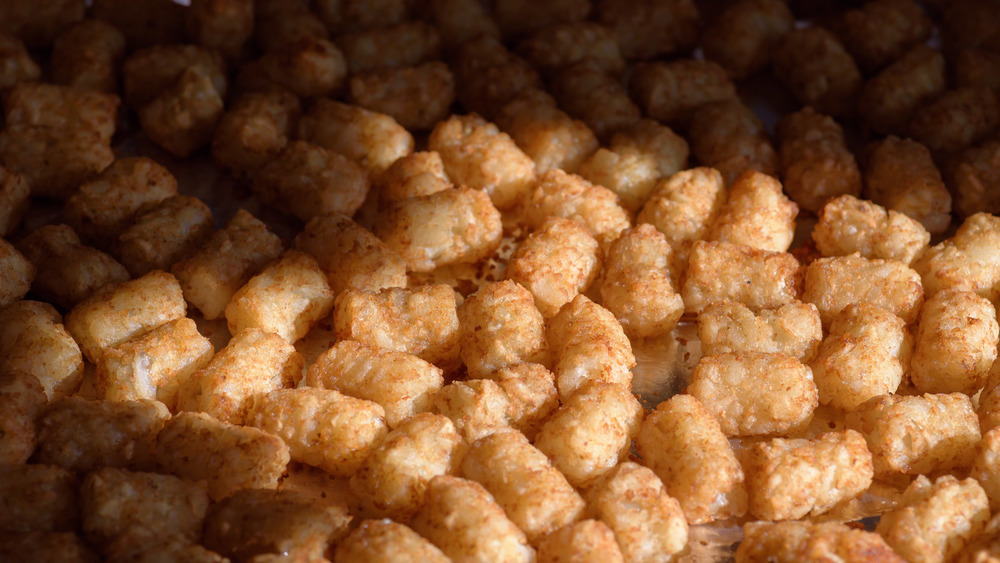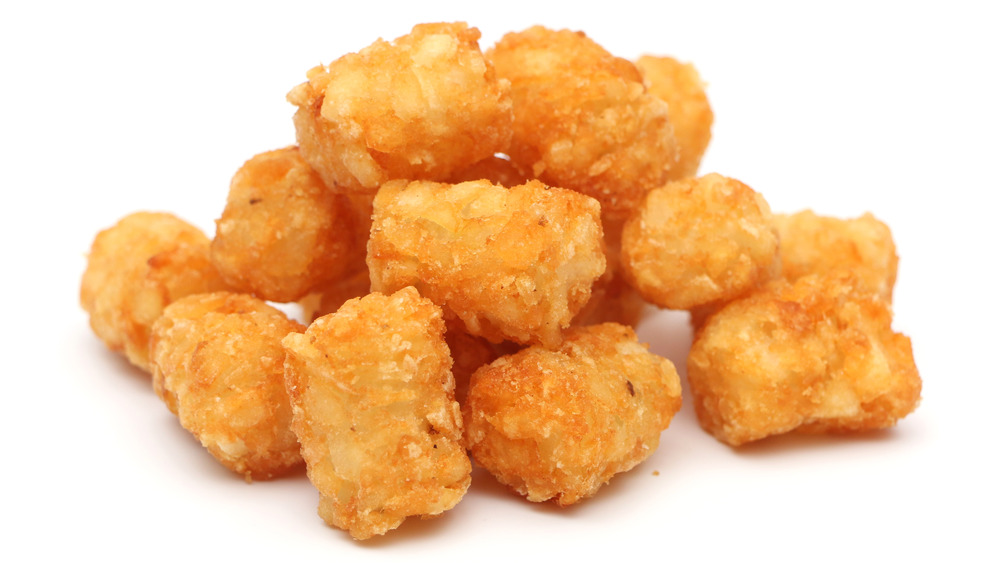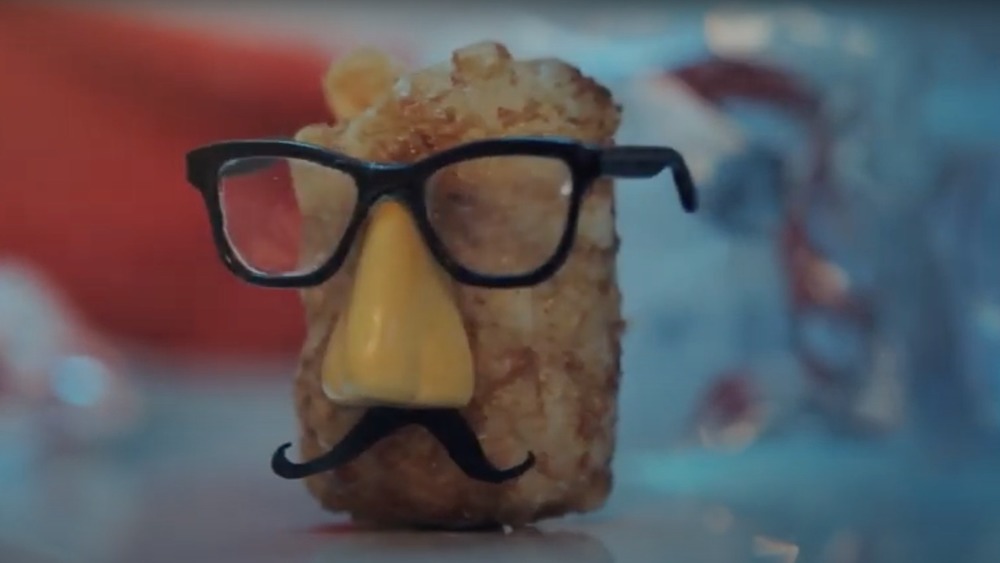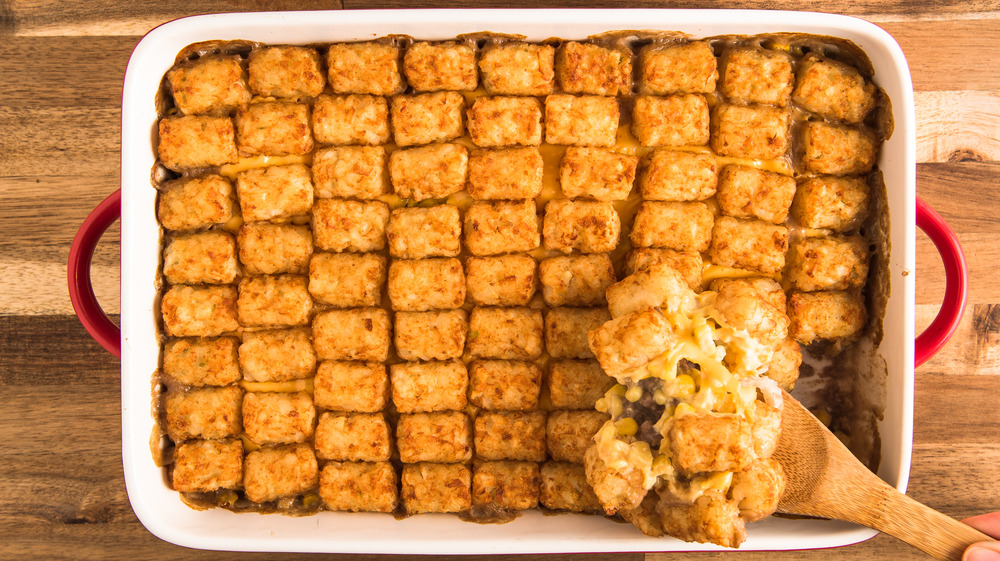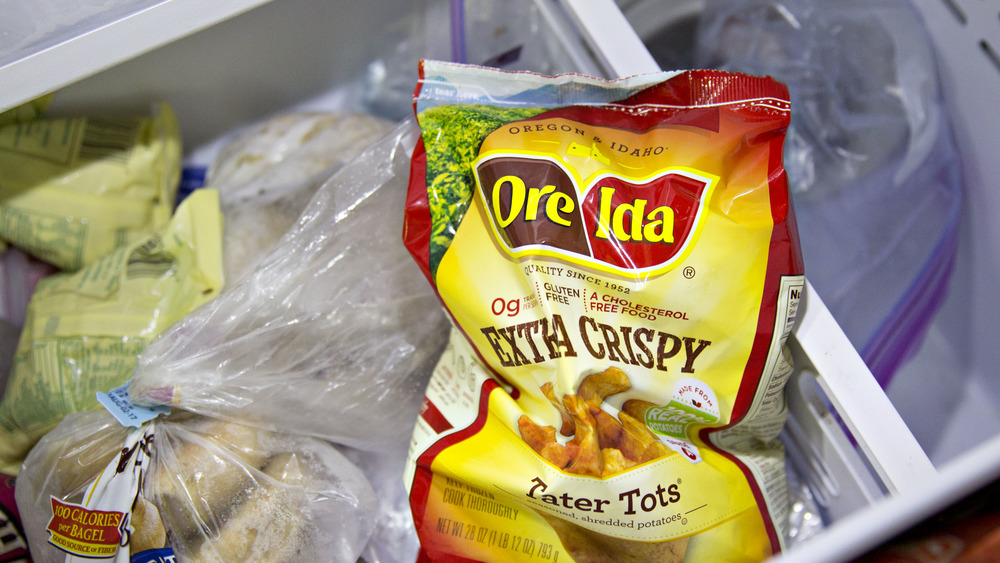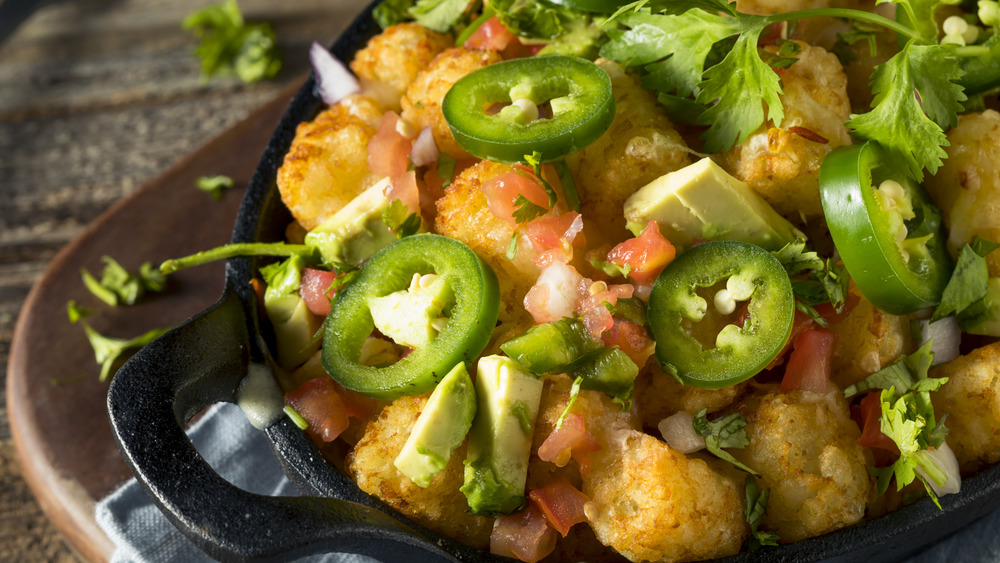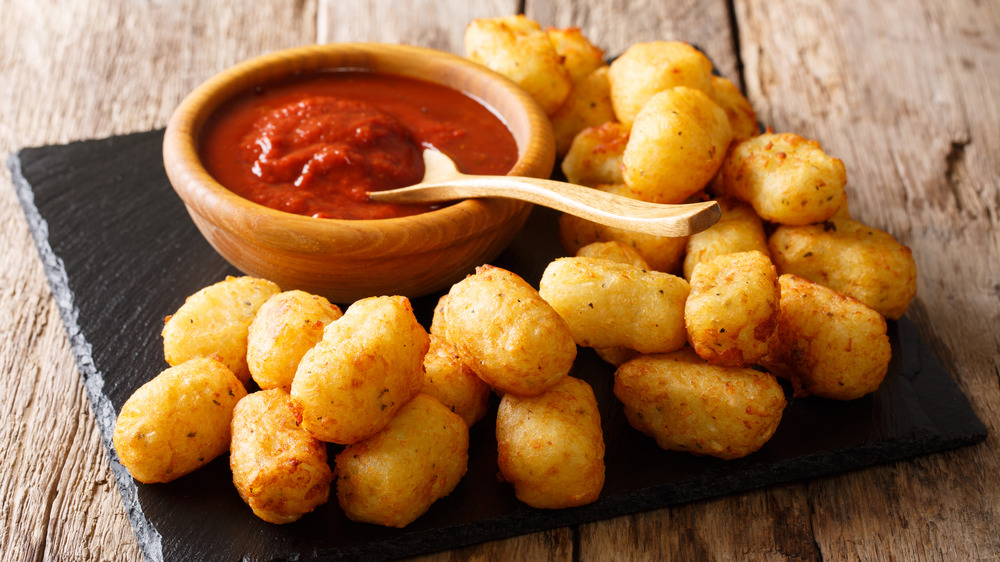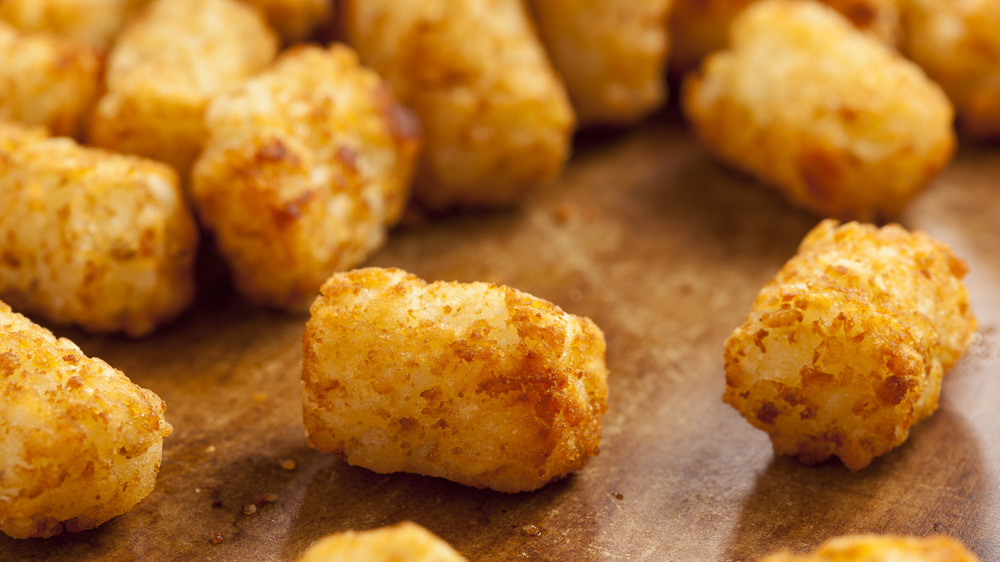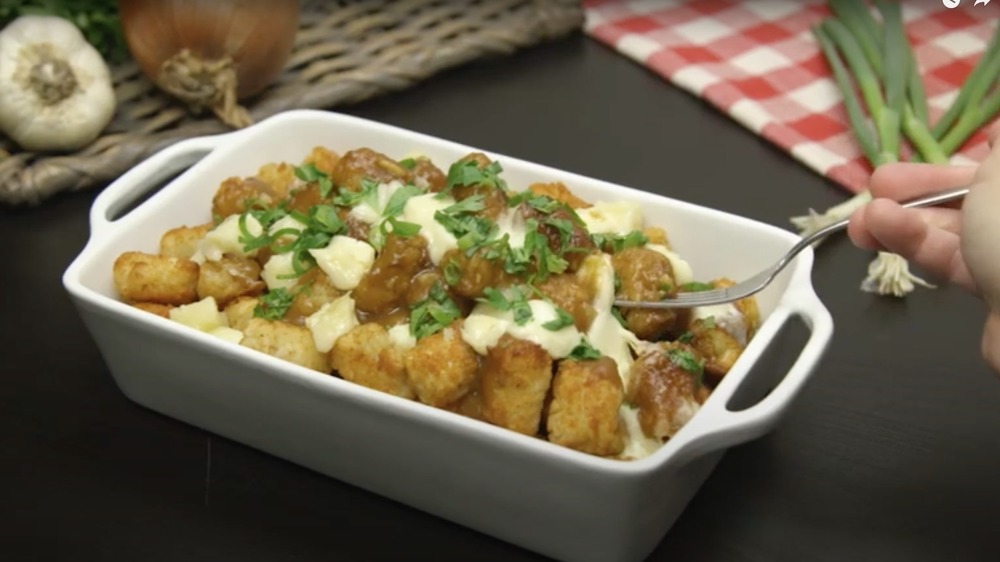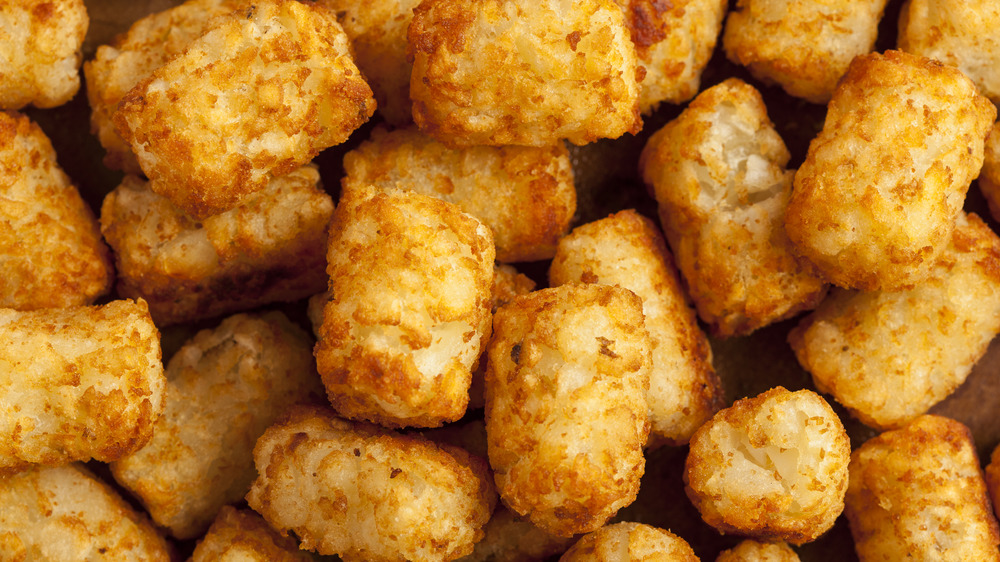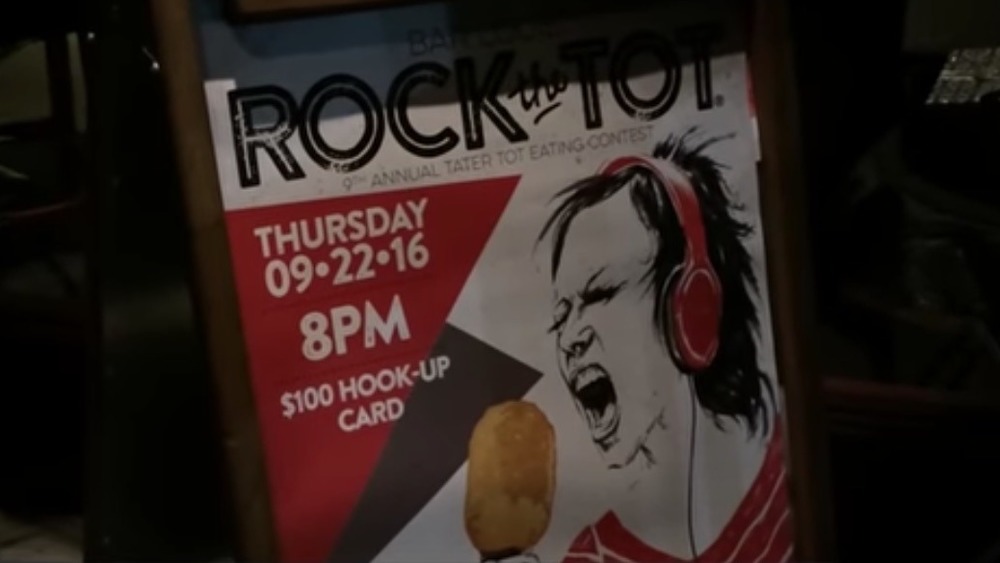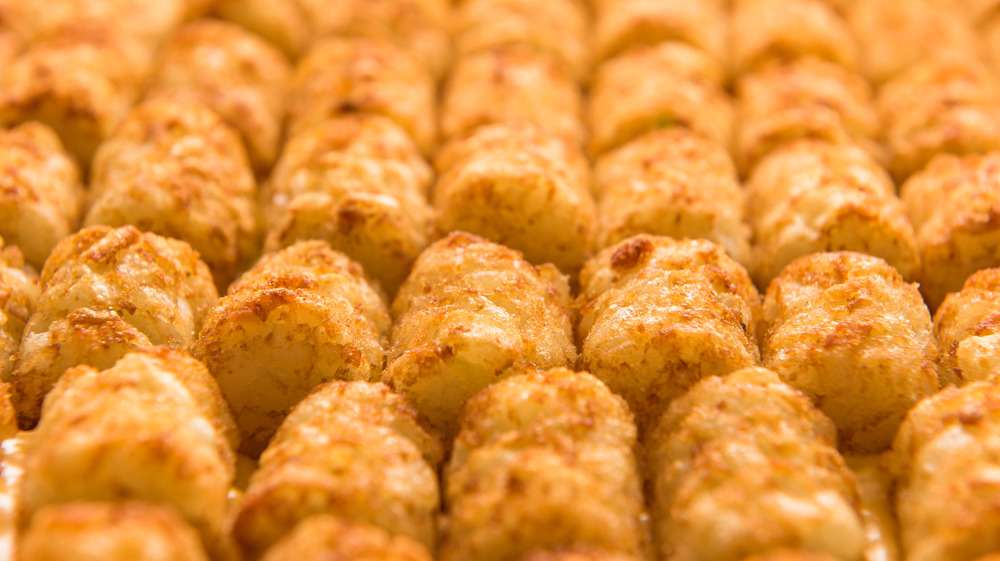The Untold Truth Of Tater Tots
Is there a more classic, all-American side dish than Tater Tots? Invented in the 1950s as a way to make use of unused potato scraps left over from the production of French fries, Tater Tots grew to become the jewel in the crown of Ore-Ida, a food company founded by sibling potato farmers. Shortly after the product's launch, recalled Eater, the small company had managed to capture a full quarter of the booming frozen potato market nationwide.
When Ore-Ida was purchased by H.L. Heinz for $30 million in 1965, the success of the brand kept escalating; after Heinz merged with Kraft Foods in 2015, Tater Tots remained one of the company's most lucrative brands. Today, Tater Tots remain a staple of everything from school lunches to late-night snack binges, and can be enjoyed in six different varieties: Original, Onion, Mini, Extra Crispy, microwavable Extra Crispy Easy, and Crispy Crowns.
After nearly seven decades on the market, Tater Tots have become downright iconic, yet how much do the product's consumers really know about these tasty potato treats? Read on to discover the untold truth of Tater Tots.
Tater Tot s are a model of American ingenuity
In 2017, Eater took a deep-dive investigative journey into the history of Tater Tots. It all began with F. Nephi Grigg and his brother, Golden Grigg, "two determined young Mormon entrepreneurs" who each owned a potato farm, selling the bounty of their land to friends and neighbors. Prior to his death in 1995, Nephi wrote his own unpublished "History of the Tot," which contained much of the information Eater used to compile its recollection of the product's early years.
Nephi was a visionary, who came to believe that frozen foods would soon dominate America's food industry. Following his hunch, the brothers mortgaged their farms and purchased a flash-freezing plant in nearby Oregon, with a plan to transform their potato crop into frozen French fries. After some trial and error, they were able to rejig the potato-cutting machinery to separate the fries from the leftover slivers, which were used as cattle feed. An entrepreneur who hated waste, Nephi cooked up the idea of compacting those unwanted potato scraps into bite-sized nuggets that could be fried or baked.
Naming their company after the two states in which they operated, Ore-Ida Foods Inc. was born.
The humble Tater Tot was introduced in a posh Miami hotel
Tater Tots made their grand debut in 1954 at Miami's chi-chi Fontainebleau hotel. That, reported Eater, was when Ore-Ida founders F. Nephi Grigg and his brother, Golden Grigg, travelled to the Florida coast to attend the National Potato Convention, held that year at the Fontainebleau.
Nephi had come up with a genius plan to launch Ore-Ida's new culinary creation in spectacular style. After tracking down the chef in the hotel's kitchen, the crafty entrepreneur bribed him to cook up 15 pounds of the potato-based invention he'd brought with him, and then serve the tots to convention attendees at breakfast.
His hunch that the potato bites would make a major impression on the assembled potato industry bigwigs was a good one. "These were all gobbled up faster than a dead cat could wag its tail," Nephi Grigg colorfully wrote of his scheme, which worked even better than he'd hoped and laid the groundwork for all the future success that lay glimmering on the horizon.
Tater Tots' name was the result of a national contest... maybe?
Ore-Ida's founders had perfected their product, invented as a way to prevent unnecessary waste in production of their flash-frozen French fries. According to Nephi's notes, reported Eater, an unnamed salesman who "traveled the markets playing a ukulele and demonstrating our product" was responsible for devising the Tater Tot moniker, armed only with "a thesaurus and an affinity for alliteration."
However, there's another origin story circulating about how the Griggs' potato-scrap side dish came to be called Tater Tots. According to The Daily Meal, the South Florida Reporter and the website of Pitco (which manufactures commercial fryers), the company created a contest, inviting folks from all over America to submit their ideas. In this version of the story, the winning entry came from housewife Clora Lay Orton, combining the word "tater" (slang for potato) and "tot," a word describing an infant — basically, baby potatoes.
"A new product has about a three-year jump on the competition," Nephi Grigg wrote. To capitalize on that brief window before the market would be flooded with imitators, the name "Tater Tot" was trademarked, new machinery purchased, and production ramped up to mass-produce their new food item.
Tater Tots fought back against knockoffs
Tater Tots quickly took off, carving out an entirely new market share that hadn't existed before; as the South Florida Reporter noted in 2019, Americans' love affair with the product had lasted for decades, and hadn't abated.
As is usually the case when a new product becomes an established hit with consumers, other companies began producing their own version of Tater Tots under different names. However, even when consumers came to buy the knockoffs, they still referred to the imitators as Tater Tots, similar to how brands such as Band-Aids, Kleenex and Corn Flakes came to become generic terms for both the original product and its imitation versions.
As The New York Times reported in 2014, Ore-Ida struck back with its "Imi-Taters" advertising campaign. In one of the commercials, Tater Tot-like products are seen wearing various disguises in hopes of tricking consumers, ranging from a Groucho Marx nose-glasses-mustache combo to a pirate outfit. "The 'Imi-Taters' campaign was very successful," said Federico Arreola, vice president of the consumer products brand business unit at Heinz, owner of the Ore-Ida brand. The campaign, Arreola added, was effective at "reminding consumers that the original is the only one."
Making your own DIY Tater Tots is an endurance test
In addition to imitation Tater Tots, the product has also been hit by competition from home cooks who've concocted their own recipes. Creating DIY Tater Tots, however, is not as easy as it might initially appear.
As Eater pointed out in its exploration of Tater Tots' history, making the bite-sized potato nuggets without all that specialized machinery is actually quite an undertaking. David Kinch, chef at acclaimed California restaurant Manresa, has shared his special recipe for DIY Tater Tots; anyone who attempts to tackle it, however, will probably want to take the day off, given that the recipe takes a whopping 12 hours to make.
As Wes Rowe, chef and owner of San Francisco's Wesburger 'N' More told Eater, they had made their own homemade Tater Tots in the past, but decided to stop doing that and instead serve customers OG Ore-Ida tots. According to Rowe, "after all the time and labor we all agreed we just love our classic Ore-Ida tots the most."
Tater Tots were at the center of a lawsuit over a carcinogenic chemical
One unfortunate side effect of the production process that creates Tater Tots is the creation of a chemical called acrylamide. As SFGate pointed out, when starch-heavy foods such as potatoes are heated at high temperatures, the process creates acrylamide. But it wasn't until 2002 that its presence was detected in food; this presented a big problem, given that the state of California was already listing acrylamide as one of the carcinogenic substances listed within Proposition 65. That legislation, passed in 1984, required that consumers be given warnings about any cancer-causing substances they may come into contact with — which included the presence of acrylamide in Tater Tots.
As the result of a lawsuit launched by the state of California against Ore-Ida and other manufacturers of potato products, Ore-Ida agreed to a settlement that involved paying $600,000 in costs and penalties, in addition to cutting acrylamide levels in the company's French fries and Tater Tots in half.
There are many ways to hack Tater Tots
Folks who love Tater Tots have unleashed their creativity on clever and occasionally bonkers recipes that take the bite-sized spud snacks in some bold new culinary directions. For example, Brit+Co compiled a roster of 17 unique hacks that use Tater Tots as the basis of everything from waffles to a bacon cheeseburger Tater Tot casserole, which looks to be as indulgent as it appears.
Other hacks include appetizers such as bacon-wrapped Tater Tot bombs, Buffalo chicken Tater Tot nachos, and even a Tater Tot breakfast pizza. For a meat-free Tater Tot hack, adventurous home cooks can try out this recipe for a Tater Tot burger with Sriracha sour cream, which uses Tater Tots to create a meatless, vegetarian patty designed to satisfy even the most ardent meat-eater. In addition, Tater Tots are also becoming popular to hack at Hanukkah, with recipes available online demonstrating how to use Tater Tots to create easy-to-make latkes.
For the sturdy of stomach, the Mythical Kitchen YouTube channel offers its hack: the Tater Tot chili bowl, combining multiple Tater Tots to create an edible bowl that's then filled with chili.
Apparently everyone's been cooking Tater Tots wrong
Anyone who's been following the cooking instructions on the packaging of Tater Tots has been doing themselves a major disservice. Or at least, that's the opinion of The Kitchn's Kelli Foster, who wrote in 2018 that cooking those little potato nuggets using the "recommended time included on the package instructions" may heat them enough to render them edible, but is "hardly enough for them to reach their full crispy-crusted, creamy-centered potential."
Foster recommends putting your stopwatch away and instead looking at "visual cues" to determine when a batch of Tater Tots has reached nirvana-like perfection. "You'll know the tots are done and ready when they have a deep golden-brown color with an outer crust that looks exceptionally crispy," she wrote. According to Foster, the brand's recommended cooking time — "25 to 35 minutes" — simply isn't long enough to achieve that Tater Tot ideal; instead, she recommends a solid 60 minutes in the oven.
As Foster pointed out, that additional cooking time "makes the most delicious difference in both the taste and texture of tater tots" by causing them to "shrink and dry out a little, which makes them even crispier all around on the outside with a potato-y center that's more dense and creamy."
A restaurateur discovered the healing power of Tater Tots
Chef Chris Ladley is the proprietor of the Nudo House restaurants in St. Louis, specializing in ramen noodles. When the COVID-19 pandemic hit, forcing restaurants throughout the country to shut their doors, he found solace in Tater Tots. As Ladley told Riverfront Times, when things "started getting really bad," his chef Qui Tran "asked me if we had anything crappy to eat in the walk-in. I told him we had Tater Tots, so I fried some up. At first, I had a small bowl. Eventually, it turned into a medium-sized one and the next thing we knew, we were eating them out of a large mixing bowl. The two of us ate an entire case of them in four days."
In fact, Ladley admitted that Tater Tots had become the "stress-eating" comfort food that helped him chow his way through some dark times. "Tater tots are like starchy, crunchy, salty anti-depressants," he admitted.
A Vancouver eatery created an entire menu based on Tater Tots
Given that Tater Tots made their official debut in a dining room at Miami's swanky Fontainebleau hotel back in the 1950s, it seems more than appropriate that, in 2018, a Vancouver eatery devised an entire menu that was entirely devoted to Tater Tots.
As Daily Hive reported at the time, for a brief and glorious six-week period in the spring of 2018, Vancouver sports bar Yaggers created an all-Tater Tots menu. The ultimate goal, noted Daily Hive, was an attempt to make all of the bar's patrons' "wildest potato-fueled dreams come true." Yaggers' specialty menu items included Tot Esquites, Cheesy Tots, and Tot Poutine; for the latter, Tater Tots were substituted for French fries in the quintessentially Quebecois specialty known as poutine, in which crispy fries — or, in this case, Tater Tots — are topped with hunks of cheese curds and drenched in savory gravy.
Americans eat a LOT of Tater Tots
America's love affair with Tater Tots has been a long-lasting one, beginning in the mid-1950s and continuing to the present. Since the iconic frozen potato dish was first introduced, Tater Tots have continued to be a favorite of U.S. consumers. In fact, according to the South Florida Reporter, by 2019 Americans were chowing down on a staggering 70 million pounds of tater tots each year.
What makes this even more extraordinary is food's humble origin, as a cost-recouping measure to prevent excess potato scraps, created in the mass production of French fries, from being wasted as cattle feed. As Ore-Ida co-founder Nephi Grigg wrote to "an Ore-Ida representative" back in 1989, he had no idea he was creating an iconic food. According to Grigg, his sole goal was to salvage "product that has been purchased from the grower, stored for months, gone thru the peeling process, gone thru the specking lines and trimmed of all the defects, only to be eliminated into the cattle feed."
There are Tater Tot eating contests, and they're not for the faint of heart
As competitive eating continues to grow in popularity, the concept has expanded beyond hot dogs, pies, and chicken wings to include Tater Tots. In fact, nationwide restaurant chain Bar Louie hosts an annual Tater Tot eating contest.
As Riverfront Times reported back in 2010, Bar Louie's "Rock the Tot" eating contest was won that year by previous champion Carl Deselm, who held onto his title for a second consecutive year after previously being named "national champ." He won the "disgustingly awesome" contest after swallowing nearly three-and-a-half pounds of Tater Tots in a mere six minutes.
As Miami New Times noted in 2013, competitors that year attempted to set a new world record for the most Tater Tots consumed within a three-minute period, in both individual competition and a relay race. "The relay race will reward speed over quantity, with each four-person team given one pound of the tiny round hash browns to consume in the least amount of time. The winning team will get free Tater Tots for a year," explained Bar Louie marketing manager Ashley Kouns, adding, "solo competitors will be challenged to eat as many tater tots as possible in three minutes."
A culinary genius combined Tater Tots with nachos to create totchos
There are indeed many ways to hack Tater Tots, using the crispy potato snacks as the basis for entirely new and unforeseen culinary delights. In that vein, fans of Tater Tots should pay tribute to Jim Parker, a former Portland journalist who was at the forefront of the Pacific Northwest city's pioneering craft beer movement. In an obituary of Parker, who passed away in 2019, The Oregonian highlighted another of his achievements: totchos.
What are totchos? Exactly what one would think, nachos but with Tater Tots substituted for corn chips, topped with black olives, melted cheese, jalapeños, sour cream, and other toppings traditionally associated with nachos. The Tater Tot-based meal became a staple of Parker's Oaks Bottom Public House in Portland. "They looked at me like I was growing a third ear," Parker said of his invention in 2015 when revealing the secret history of totchos. "They said, 'That sounds like stoner food.' They were humoring me to put them on the menu, but it ended up being one of our most ordered items."
Tater Tots made their way into a hit superhero movie
Tater Tots are more than just a delicious snack; in fact, the bite-sized potato gems have also become a part of pop culture. This became evident in the 2018 film Venom, based on the Marvel Comics character. As played by actor Tom Hardy, Eddie Brock is a maverick journalist who becomes paired with an alien symbiote to become the titular Venom, a massive, monstrous beast with a seemingly insatiable appetite — which Hardy attempts to satiate in a memorable scene by pouring an entire bag of still-frozen Tater Tots down his gullet.
In an interview with SyFyWire, director Ruben Fleischer explained the character's obsession with Tater Tots, which had nothing to do with product placement. "There was no deal with Ore-Ida, it just was in the script originally," Fleischer revealed. "It was always kind of a funny thing that the writers came up with, that he loves Tater Tots. We actually had to pare it down a little bit. There was a scene that we shot that didn't make it in the film, where he's at the grocery store buying and the Venom tendrils come out and grab a bunch of Tater Tots."
